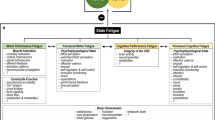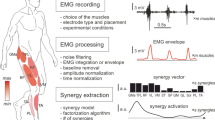Abstract
Analysis of neuromuscular fatigue finds various applications ranging from clinical studies to biomechanics. Surface electromyography (sEMG) signals are widely used for these studies due to its non-invasiveness. During cyclic dynamic contractions, these signals are nonstationary and cyclostationary. In recent years, several nonstationary methods have been employed for the muscle fatigue analysis. However, cyclostationary based approach is not well established for the assessment of muscle fatigue. In this work, cyclostationarity associated with the biceps brachii muscle fatigue progression is analyzed using sEMG signals and Spectral Correlation Density (SCD) functions. Signals are recorded from fifty healthy adult volunteers during dynamic contractions under a prescribed protocol. These signals are preprocessed and are divided into three segments, namely, non-fatigue, first muscle discomfort and fatigue zones. Then SCD is estimated using fast Fourier transform accumulation method. Further, Cyclic Frequency Spectral Density (CFSD) is calculated from the SCD spectrum. Two features, namely, cyclic frequency spectral area (CFSA) and cyclic frequency spectral entropy (CFSE) are proposed to study the progression of muscle fatigue. Additionally, degree of cyclostationarity (DCS) is computed to quantify the amount of cyclostationarity present in the signals. Results show that there is a progressive increase in cyclostationary during the progression of muscle fatigue. CFSA shows an increasing trend in muscle fatiguing contraction. However, CFSE shows a decreasing trend. It is observed that when the muscle progresses from non-fatigue to fatigue condition, the mean DCS of fifty subjects increases from 0.016 to 0.99. All the extracted features found to be distinct and statistically significant in the three zones of muscle contraction (p < 0.05). It appears that these SCD features could be useful in the automated analysis of sEMG signals for different neuromuscular conditions.









Similar content being viewed by others
References
Enoka, R. M., and Duchateau, J., Muscle fatigue: What, why and how it influences muscle function. J. Physiol. 586:11–23, 2008.
Boyas, S., and Guevel, A., Neuromuscular fatigue in healthy muscle: Underlying factors and adaptation mechanisms. Ann. Phys. Rehabil. Med. 54:88–108, 2011.
Mohamed, R. A. M., Francisco, S., and Colley, M., Evolved pseudo-wavelet function to optimally decompose sEMG for automated classification of localized muscle fatigue. Med. Eng. Phys. 33:411–417, 2011.
Chaudhuri, A., and Behan, P. O., Fatigue in neurological disorder –Review. Lancet 363:978–988, 2004.
Falup, P. C., Fatigue assessment of Parkinson’s disease patient in clinic: Specific versus holistic. J. Neural Transm. 120:577–581, 2013.
Carolyn, A. G., and David, A. J., Muscle physiology. Surgery 28:55–59, 2009.
Liang, M., Damien, C., Fouad, B., Wei, Z., Bo, H., and François, G., A novel approach for determining fatigue resistances of different muscle groups in static cases. Int. J. Ind. Ergon. 41:10–18, 2011.
Song, J. H., Jung, J. W., and Zeungnam, B., Robust EMG pattern recognition to muscular fatigue effect for human- machine interaction. J. Intell. Fuzzy Syst. 20:3–12, 2009.
Thrasher, A., Graham, G. M., and Popovic, M. R., Reducing muscle fatigue due to functional electrical stimulation using random modulation of stimulation parameters. Artif. Organs 9:453–458, 2005.
Vladimir, M., Stanko, T., and Sasa, O., Surface EMG based muscle fatigue evaluation in biomechanics. Clin. Biomech. 24:327–340, 2009.
Reaz, M. B. I., Hussain, M. S., and Mohd Yasin, F., Techniques of EMG signal analysis: Detection, processing, classification and applications. Biol. Proced. Online 8:11–35, 2006.
Merletti, R., and Parker, P. Electromyography: physiology, engineering, and non-invasive applications: Wiley, p. 11, 2004.
Geoffrey, L. S., Application of time-varying analysis to diagnostic needle electromyography. Med. Eng. Phys. 34:249–255, 2012.
Fuglsang-Frederiksen, A., The role of different EMG methods in evaluating myopathy. Clin. Neurophysiol. 117:1173–1189, 2006.
Filligoi, G., and Felici, F., Detection of hidden rhythms in surface EMG signals with a non-linear time-series tool. Med. Eng. Phys. 21:439–448, 1999.
Hogrel, J.-Y., Clinical applications of surface electromyography in neuromuscular disorders. Clin. Neurophysiol. 35:59–71, 2005.
Bonato, P., Roy, S. H., Knaflitz, M., and De Luca, C. J., Time-frequency parameters of the surface myoelectric signal for assessing muscle fatigue during cyclic dynamic contractions. IEEE Trans. Biomed. Eng. 48:745–753, 2001.
Karthick, P. A., and Ramakrishnan, S. Analysis of fatigue conditions in biceps brachii muscles using surface electromyography signals and strip spectral correlation IEEE 19th International Conference on In Digital Signal Processing 190–194, 2014.
Roy, S. H., Bonato, P., and Knaflitz, M., EMG assessment of back muscle function during cyclical lifting. J. Electromyogr. Kinesiol. 8:233–245, 1998.
Kumar, D. K., Pah, N. D., and Bradley, B., Wavelet analysis of surface electromyography to determine muscle fatigue. IEEE Trans. Neural Syst. Rehabil. Eng. 11:400–406, 2003.
Karthick, P. A., Venugopal, G., and Ramakrishnan, S., Analysis of surface EMG signals under fatigue and non-fatigue conditions using B-distribution based quadratic time frequency distribution. J. Mech. Med. Biol. 15:1–6, 2015.
Ke, L., Hogrel, J.-Y., Jacques, D., and David, J. H., Analysis of fatigue and tremor during sustained maximal grip contractions using Hilbert-Huang Transformation. Med. Eng. Phys. 34:832–840, 2012.
Mihandoost, S., and Amirani, M. C., EEG signal analysis using spectral correlation function & GARCH model. SIViP, 2014. doi:10.1007/s11760-013-0600-9.
Li, T., Qiu, T., and Tang, H., Optimum heart sound signal selection based on the cyclostationary property. Comput. Biol. Med. 43:607–612, 2013.
Li, T., Tang, H., Qiu, T., and Park, Y., Heart sound cancellation from lung sound record using cyclostationarity. Med. Eng. Phys. 35:1831–1836, 2013.
Gupta, C. N., and Palaniappan, R., Enhanced detection of visual-evoked potentials in brain-computer interface using genetic algorithm and cyclostationary analysis. Comput. Intell. Neurosci. 2007. doi:10.1155/2007/28692.
Roussel, J., Haritopoulos, M., Ravier, P., and Buttelli, O. Cyclostationary analysis of electromyographic signal 21th European Signal Processing Conference, Morocco, 2013.
Schnur, S. R. Identification and classification of OFDM based signals using preamble correlation and cyclostationary feature extraction, PhD thesis, Naval Postgraduate School, 2009.
Da Costa, E. L. (1996) Detection and Identification of Cyclostationary Signals, Master’s Thesis, March.
Venugopal, G., and Ramakrishnan, S., Analysis of progressive changes associated with muscle fatigue in dynamic contraction of biceps brachii muscle using surface EMG signals and bispectrum features. Biomed. Eng. Lett. 4:269–276, 2014.
Venugopal, G., Navaneethakrishna, M., and Ramakrishnan, S., Extraction and analysis of multiple time window features associated with muscle fatigue conditions using sEMG signals. Expert Syst. Appl. 41:2652–2659, 2014.
Sachin, S., and Gaurav, K., Wavelet analysis based feature extraction for pattern classification from single channel acquired EMG signal. Elixir Control. Eng. 50:10320–10324, 2012.
Živanović, G. D., and Gardner, W. A., Degrees of cyclostationarity and their application to signal detection and estimation. Signal Process. 22(3):287–297, 1991.
Roussel, J., Haritopoulos, M., Ravier, P., and Buttelli, O. A new cyclostationarity-based blind approach for motor unit’s firing rate automated detection in electromyographic signals International Conference on Biomedical and Health Informatics, pp. 656–659, 2014.
Bigland-Ritchie, B., EMG/force relations and fatigue of human voluntary contractions. Exerc. Sport Sci. Rev. 9:75–117, 1981.
Naik, G.R., Kumar, D.K., Yadav, V., Wheeler, K., and Arjunan, S. Testing of motor unit synchronization model for localized muscle fatigue 31st Annual International Conference of Engineering in Medicine and Biology Society, pp. 360–363, 2009.
Arendt-Nielsen, L., and Mills, K. R., Muscle fibre conduction velocity, mean power frequency, mean EMG voltage and force during submaximal fatiguing contractions of human quadriceps. Eur. J. Appl. Physiol. 58:20–25, 1988.
Author information
Authors and Affiliations
Corresponding author
Additional information
This article is part of the Topical Collection on Systems-Level Quality Improvement
Rights and permissions
About this article
Cite this article
Karthick, P.A., Venugopal, G. & Ramakrishnan, S. Analysis of Muscle Fatigue Progression using Cyclostationary Property of Surface Electromyography Signals. J Med Syst 40, 28 (2016). https://doi.org/10.1007/s10916-015-0394-0
Received:
Accepted:
Published:
DOI: https://doi.org/10.1007/s10916-015-0394-0




